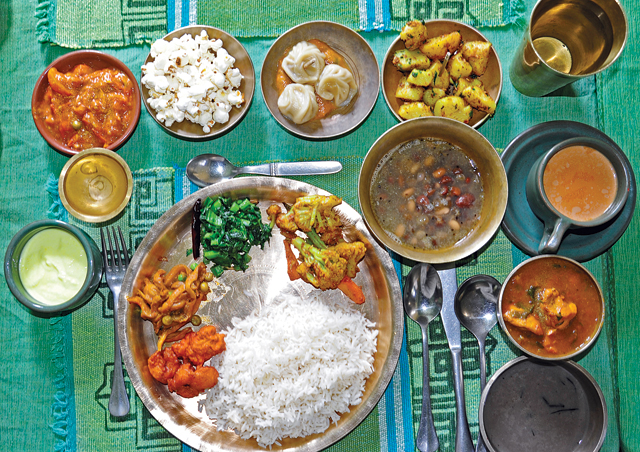There might be some people who, when they think of fine dining, think only of western-style restaurants. But they’d be wrong.

In the centre of Kathmandu, a 17 year old restaurant in a 108 year old building is showing how to do fine dining, the local way. I’m talking about Bhojan Griha, in DilliBazar. This huge neoclassical style building was once home to the priest to the royal palace; now it’s one of the city’s best traditional restaurants.
Only Nepali food is served, and there are two dining options: an a la carte menu, or the set menu, the latter of which is by far the most popular option, and what we’re having.
It begins with snacks—crispy alu, qwatti soup, and mo:mo, then moves on to a full set Nepali meal: creamy dal and rice with all the fixings. I was particularly delighted with the mushroom curry, an unusual addition, and not to forget the chicken curry which was really well-made and different than what you find in most Nepali restaurants.Somehow the flavours and quality reminded you of the best sort of home cooked meal. We finished with a small dish of rich yogurt—homemade, with cardamom powder and honey. Delicious. With the exception of the meat, all of the ingredients that made up our meal were completely organic. Much of the produce comes from the restaurant’s own farm in Gundu, Bhaktapur, and the remainder is sourced from select organic farms. Bhojan Griha is committed to both environmental practices (for instance, no bottled water is sold here) and sourcing ingredients and materials from local farmers and businesses. Even the aila served is a home-made product, made by a family in Bhaktapur exclusively for them. It’s little touches like this and the attention to quality and service that elevate the whole dining experience.
There are three big halls and two small ones, and the restaurant can accommodate two hundred people. Each night a six or seven musical acts (out of a total of thirteen) perform, rotating through the different dining halls during the course of dinner. And if you want more than aila, there are two bars with a full selection of spirits and cocktails.
The restaurant’s clientele include not only tour groups, but also film actors, ambassadors and prime ministers, and in years past the late King Birendra and his family were diners here, too. Government ministries often bring delegations of foreign visitors here to showcase Nepal’s culture and food.
I have to admit that a great deal of the appeal is not just the food but the entire atmosphere: from the dishes to the chairs and table settings, as much as possible everything is made in Nepal by local artisans, and the building itself is a formidable and awesome presence. It’s the most fascinating juxtaposition of local and old European architecture; they don’t make buildings like this anymore, which is a pity. It’s a beautiful piece of living history and definitely worth a visit.










